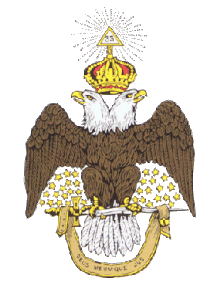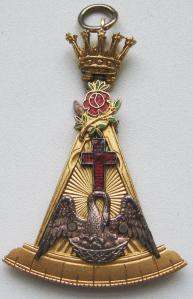
Back Şotland Riti Azerbaijani Ritu Escocès Antic i Acceptat Catalan Σκωτικός Τύπος Greek Malnova kaj Akceptita Skota Rito Esperanto Rito Escocés Antiguo y Aceptado Spanish Skottilainen riitti Finnish Rite écossais ancien et accepté French Škotski obred Croatian Ritus Skotlandia ID Rito scozzese antico ed accettato Italian

| Part of a series on |
| Freemasonry |
|---|
 |
The Ancient and Accepted Scottish Rite of Freemasonry is a rite within the broader context of Freemasonry. It is the most widely practiced Rite in the world.[1][2][3] In some parts of the world, and in the Droit Humain, it is a concordant body and oversees all degrees from the 1st to 33rd degrees, while in other areas, a Supreme Council oversees the 4th to 33rd degrees.
It is most commonly referred to as the Scottish Rite. Sometimes, as in England and Australia, it is called the Rose Croix,[4][5] though this is just one of its degrees, and is not to be confused with other Masonic related Rosicrucian societies such as the Societas Rosicruciana in Anglia. Its name may vary slightly in various jurisdictions and constitutions. For example, the English and Irish Constitutions[6] omit the word Scottish.[7][8]
The Scottish Rite stands as a full Rite of Freemasonry and not an appendant body.[9] Master Masons from other rites may, in some countries, join the Scottish Rite's upper degrees starting from the 4th degree due to its popularity.[10][11] This Rite builds upon the ethical teachings and philosophy offered in the Craft (or Blue) Lodge through dramatic presentations of its individual degrees. The term "Blue Lodge" refers to the first three degrees of Masonry, regardless of the Rite being practiced. In the Scottish Rite system, the first three degrees are considered Blue Lodge degrees rather than "Red Lodge".[12]

- ^ Ancient and Accepted Scottish Rite of Freemasonry
- ^ "Our Rite – Orient of Utah".
- ^ "The Scottish Rite". Scottish Rite Orient of Georgia.
- ^ "The Supreme Council". sc33.org.uk. Archived from the original on 29 September 2017. Retrieved 28 April 2018.
- ^ "The Ancient and Accepted Rite". Archived from the original on 2023-05-29. Retrieved 2023-05-29.
- ^ "Ancient and Accepted Rite for Ireland | Grand Lodge of Ireland". Retrieved 2024-01-26.
- ^ Grand Lodge Of Ireland. "Ancient and Accepted Rite for Ireland". Retrieved 14 November 2023.
- ^ "Introduction". The Supreme Council 33. Retrieved January 19, 2024.
- ^ "Resources - Robert Burns Lodge No. 59". August 2023.
- ^ "How to Join – Scottish Rite of Freemasonry, S.J., U.S.A." Scottish Rite of Freemasonry, S.J., U.S.A. Archived from the original on 2017-07-03. Retrieved 2017-06-12.
- ^ "Become a member". Scottish Rite Omaha. Archived from the original on 2016-08-30. Retrieved 2017-06-12.
- ^ "Some Lodges Are Different".